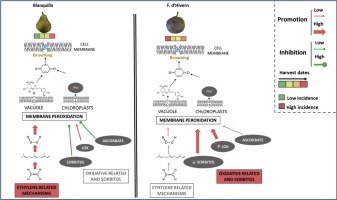当前位置:
X-MOL 学术
›
Postharvest Biol. Technol.
›
论文详情
Our official English website, www.x-mol.net, welcomes your
feedback! (Note: you will need to create a separate account there.)
The relationship between ethylene- and oxidative-related markers at harvest with the susceptibility of pears to develop superficial scald
Postharvest Biology and Technology ( IF 6.4 ) Pub Date : 2020-05-01 , DOI: 10.1016/j.postharvbio.2020.111135 Violeta Lindo-García , Jordi Giné-Bordonaba , Chloé Leclerc , Dolors Ubach , Christian Larrigaudière
Postharvest Biology and Technology ( IF 6.4 ) Pub Date : 2020-05-01 , DOI: 10.1016/j.postharvbio.2020.111135 Violeta Lindo-García , Jordi Giné-Bordonaba , Chloé Leclerc , Dolors Ubach , Christian Larrigaudière

|
Abstract To better understand the specific biochemical pathways involved in superficial scald susceptibility, changes in ethylene biosynthesis, antioxidant, oxidative related processes and sugar metabolism were investigated for two scald sensitive pear cultivars (‘Blanquilla’ and ‘Flor d’Hivern’) with distinct postharvest ripening patterns at different harvest dates. Both cultivars developed symptoms of scald after 4 months of storage at -0.5 °C, but the biochemical basis underlying the fruit susceptibility were different. In the summer pear ‘Blanquilla’, capable of ripening even on the tree, scald susceptibility was higher in fruit of advanced maturity and was associated with the action of ethylene on triggering the expression of PcAFS1 gene. In this cultivar, the levels of ACC, ACS enzyme activity and PcAFS1 at harvest were strongly correlated to scald incidence. In contrast, in the winter pear, ‘Flor d’Hivern’, with little or no ethylene-production capacity even after cold storage, scald symptoms were already visible when fruit were removed from cold storage, regardless of the fruit maturity. In this pear cultivar, scald symptoms were not dependent on ethylene, but rather associated with higher lipoxygenase (LOX) activity at harvest, an enzyme often associated with responses to chilling injury, and lower content of sorbitol, a compound that may act as cryoprotectant preventing cell damage during cold storage.
中文翻译:

采收时乙烯和氧化相关标志物与梨表浅烫伤敏感性的关系
摘要 为了更好地了解浅表烫伤敏感性的具体生化途径,研究了两种具有不同采后烫伤敏感性的梨品种('Blanquilla'和'Flor d'Hivern')的乙烯生物合成、抗氧化、氧化相关过程和糖代谢的变化。不同收获日期的成熟模式。两个品种在 -0.5 °C 下储存 4 个月后均出现烫伤症状,但果实易感性的生化基础不同。在夏梨'Blanquilla'中,即使在树上也能成熟,成熟后果实的烫伤敏感性更高,这与乙烯触发PcAFS1基因表达的作用有关。在这个品种中,ACC 的水平,ACS 酶活性和收获时的 PcAFS1 与烫伤发生率密切相关。相比之下,冬季梨 'Flor d'Hivern' 即使在冷藏后也很少或没有乙烯生产能力,无论果实成熟度如何,从冷藏中取出果实时都已经出现烫伤症状。在这个梨品种中,烫伤症状不依赖于乙烯,而是与收获时较高的脂氧合酶 (LOX) 活性有关,这种酶通常与对冷害的反应有关,山梨糖醇含量较低,山梨糖醇是一种可作为冷冻保护剂预防冷藏期间细胞损坏。无论水果成熟度如何,当水果从冷藏库中取出时,烫伤症状已经很明显了。在这个梨品种中,烫伤症状不依赖于乙烯,而是与收获时较高的脂氧合酶 (LOX) 活性有关,这种酶通常与对冷害的反应有关,山梨糖醇含量较低,山梨糖醇是一种可作为冷冻保护剂预防冷藏期间细胞损坏。无论水果成熟度如何,当水果从冷藏库中取出时,烫伤症状已经很明显了。在这个梨品种中,烫伤症状不依赖于乙烯,而是与收获时较高的脂氧合酶 (LOX) 活性有关,这种酶通常与对冷害的反应有关,山梨糖醇含量较低,山梨糖醇是一种可作为冷冻保护剂预防冷藏期间细胞损坏。
更新日期:2020-05-01
中文翻译:

采收时乙烯和氧化相关标志物与梨表浅烫伤敏感性的关系
摘要 为了更好地了解浅表烫伤敏感性的具体生化途径,研究了两种具有不同采后烫伤敏感性的梨品种('Blanquilla'和'Flor d'Hivern')的乙烯生物合成、抗氧化、氧化相关过程和糖代谢的变化。不同收获日期的成熟模式。两个品种在 -0.5 °C 下储存 4 个月后均出现烫伤症状,但果实易感性的生化基础不同。在夏梨'Blanquilla'中,即使在树上也能成熟,成熟后果实的烫伤敏感性更高,这与乙烯触发PcAFS1基因表达的作用有关。在这个品种中,ACC 的水平,ACS 酶活性和收获时的 PcAFS1 与烫伤发生率密切相关。相比之下,冬季梨 'Flor d'Hivern' 即使在冷藏后也很少或没有乙烯生产能力,无论果实成熟度如何,从冷藏中取出果实时都已经出现烫伤症状。在这个梨品种中,烫伤症状不依赖于乙烯,而是与收获时较高的脂氧合酶 (LOX) 活性有关,这种酶通常与对冷害的反应有关,山梨糖醇含量较低,山梨糖醇是一种可作为冷冻保护剂预防冷藏期间细胞损坏。无论水果成熟度如何,当水果从冷藏库中取出时,烫伤症状已经很明显了。在这个梨品种中,烫伤症状不依赖于乙烯,而是与收获时较高的脂氧合酶 (LOX) 活性有关,这种酶通常与对冷害的反应有关,山梨糖醇含量较低,山梨糖醇是一种可作为冷冻保护剂预防冷藏期间细胞损坏。无论水果成熟度如何,当水果从冷藏库中取出时,烫伤症状已经很明显了。在这个梨品种中,烫伤症状不依赖于乙烯,而是与收获时较高的脂氧合酶 (LOX) 活性有关,这种酶通常与对冷害的反应有关,山梨糖醇含量较低,山梨糖醇是一种可作为冷冻保护剂预防冷藏期间细胞损坏。









































 京公网安备 11010802027423号
京公网安备 11010802027423号